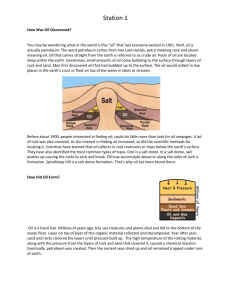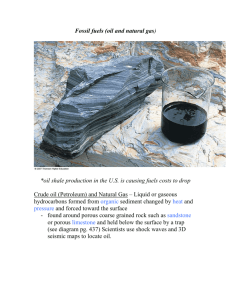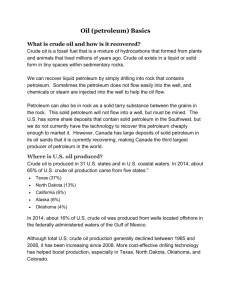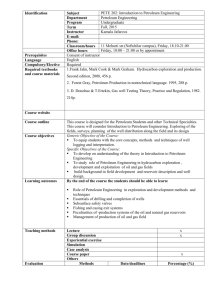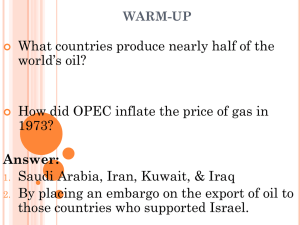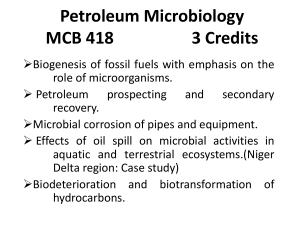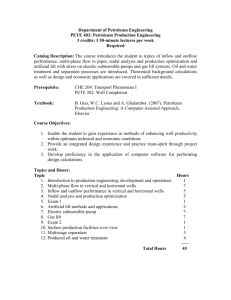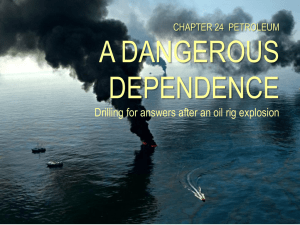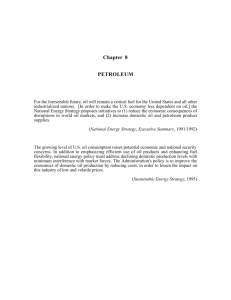Oil (petroleum) Basics
advertisement
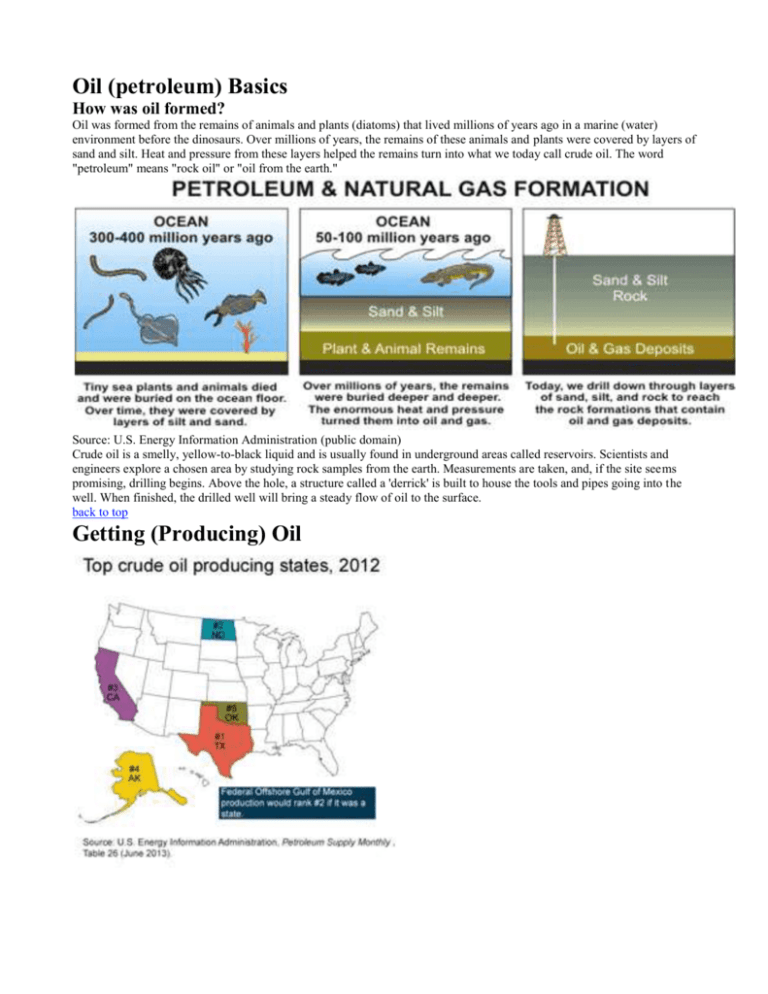
Oil (petroleum) Basics How was oil formed? Oil was formed from the remains of animals and plants (diatoms) that lived millions of years ago in a marine (water) environment before the dinosaurs. Over millions of years, the remains of these animals and plants were covered by layers of sand and silt. Heat and pressure from these layers helped the remains turn into what we today call crude oil. The word "petroleum" means "rock oil" or "oil from the earth." Source: U.S. Energy Information Administration (public domain) Crude oil is a smelly, yellow-to-black liquid and is usually found in underground areas called reservoirs. Scientists and engineers explore a chosen area by studying rock samples from the earth. Measurements are taken, and, if the site seems promising, drilling begins. Above the hole, a structure called a 'derrick' is built to house the tools and pipes going into the well. When finished, the drilled well will bring a steady flow of oil to the surface. back to top Getting (Producing) Oil Where is oil produced? Crude oil is produced in 31 states and U.S. coastal waters. In 2012, 61% of U.S. crude oil production came from five states: Texas (31%) North Dakota (10%) California (8%) Alaska (8%) Oklahoma (4%) As of 2012, about 20% of U.S. crude oil was produced from wells located offshore in federally administered waters of the Gulf of Mexico. Although total U.S. crude oil production generally declined between 1985 and 2008, it has been increasing since 2008. More cost effective drilling technology has helped boost production, especially in North Dakota, Texas, and the offshore Gulf of Mexico. Natural gas plant liquids (NGPL) are liquids that are separated from natural gas at processing plants and are important ingredients for manufacturing plastics and gasoline. Propane is the only NGPL that is widely used for heating and cooking. Production of NGPL fluctuates with natural gas production, but their share of total U.S. petroleum production has increased from 8% in 1950 to 27% in 2012. In 2012, the United States relied on net imports (imports minus exports) for about 40% of the petroleum that we used. About 100 countries produce crude oil and NGPL. The top five producing countries in 2012 and their share of total world production were: Saudi Arabia (13%) Russia (12%) United States (12%) China (5%) Canada (4%) After the fall of the Union of Soviet Socialist Republics (USSR) in 1991, Saudi Arabia became the world’s top petroleum producer. What Fuels Are Made From Crude Oil? Note: A 42-U.S. gallon barrel of crude oil yields about 45 gallons of petroleum products. What Fuels Are Made from Crude Oil? After crude oil is removed from the ground, it is sent to a refinery by pipeline, ship, or barge. At a refinery, different parts of the crude oil are separated into useable petroleum products. Crude oil is measured in barrels (abbreviated "bbls"). A 42-U.S. gallon barrel of crude oil provides about 45 gallons of petroleum products. This gain from processing the crude oil is similar to what happens to popcorn, which gets bigger after it's popped. The gain from processing is 7%. One barrel of crude oil, when refined, produces about 19 gallons of finished motor gasoline, and 10 gallons of diesel, as well as other petroleum products. Most petroleum products are used to produce energy. For instance, many people across the United States use propane to heat their homes. A Night Photo of the Pascagoula Refinery in Mississippi Source: Stock photography (copyrighted) Other products made from petroleum include: Ink Crayons Dishwashing liquids Deodorant Eyeglasses CDs and DVDs Tires Ammonia Heart valves Oil & the Environment How Does Oil Impact the Environment? Products from oil (petroleum products) help us do many things. We use them to fuel our airplanes, cars, and trucks, to heat our homes, and to make products like medicines and plastics. Even though petroleum products make life easier — finding, producing, moving, and using them can harm the environment through air and water pollution. Emissions and Byproducts Are Produced from Burning Petroleum Products Petroleum products give off the following emissions when they are burned as fuel: Carbon dioxide (CO2) Carbon monoxide (CO) Sulfur dioxide (SO2) Nitrogen oxides (NOX) and Volatile Organic Compounds (VOC) Particulate matter (PM) Lead and various air toxics such as benzene, formaldehyde, acetaldehyde, and 1,3-butadiene may be emitted when some types of petroleum are burned Nearly all of these byproducts have negative impacts on the environment and human health: Carbon dioxide is a greenhouse gas and a source of global warming.1 SO2 causes acid rain, which is harmful to plants and to animals that live in water, and it worsens or causes respiratory illnesses and heart diseases, particularly in children and the elderly. NOX and VOCs contribute to ground-level ozone, which irritates and damages the lungs. PM results in hazy conditions in cites and scenic areas, and, along with ozone, contributes to asthma and chronic bronchitis, especially in children and the elderly. Very small, or “fine PM” is also thought to cause emphysema and lung cancer. Lead can have severe health impacts, especially for children, and air toxics are known or probable carcinogens. Laws Help Reduce Pollution from Oil No Dumping/Drains to River Sign Source: Stock photography (copyrighted) Fish Swimming Through "Rigs-to-Reefs" Project Source: Courtesy of the Mississippi Department of Marine Resources Over the years, new technologies and laws have helped to reduce problems related to petroleum products. As with any industry, the Government monitors how oil is produced, refined, stored, and sent to market to reduce the impact on the environment. Since 1990, fuels like gasoline and diesel fuel have also been improved so that they produce less pollution when we use them. Reformulated Fuels Because a lot of air pollution comes from cars and trucks, many environmental laws have been aimed at changing the make-up of gasoline and diesel fuel so that they produce fewer emissions. These "reformulated fuels" are much cleanerburning than gasoline and diesel fuel were in 1990. Technology Helps Reduce Drilling's "Footprint" Exploring and drilling for oil may disturb land and ocean habitats. New technologies have greatly reduced the number and size of areas disturbed by drilling, sometimes called "footprints."2 Satellites, global positioning systems, remote sensing devices, and 3-D and 4-D seismic technologies make it possible to discover oil reserves while drilling fewer wells. The use of horizontal and directional drilling makes it possible for a single well to produce oil from a much bigger area. Today's production footprints are also smaller those 30 years ago because of the development of movable drilling rigs and smaller "slimhole" drilling rigs. When the oil in a well becomes uneconomic to produce, the well must be plugged below ground, making it hard to tell that it was ever there. As part of the "rigs-to-reefs" program, some old offshore rigs are tipped over and left on the sea floor to become artificial reefs that attract fish and other marine life. Within six months to a year after a rig is toppled, it becomes covered with barnacles, coral, sponges, clams, and other sea creatures. If oil is spilled into rivers or oceans, it can harm wildlife. When we talk about "oil spills," people usually think about oil that leaks from a ship that is involved in an accident. The amount of oil spilled from ships dropped significantly during the 1990s partly because new ships were required to have a "double-hull" lining to protect against spills. Natural Seeps are a Major Source of Oil in Ocean Water While oil spills from ships and offshore platforms are the most well-known source of oil in ocean water, a lot of oil actually gets into water from natural oil seeps coming from the ocean floor. The natural seeps may be a "major" source of oil that enters the environment globally, but they are slow, small, and spread out over large areas, and the ecosystem has adapted to them, versus the catastrophic impact that a tanker or well spill has on the areas affected. Leaks also happen when we use petroleum products on land. For example, gasoline sometimes drips onto the ground when people are filling their gas tanks, when motor oil gets thrown away after an oil change, or when fuel escapes from a leaky storage tank. When it rains, the spilled products get washed into the gutter and eventually flow to rivers and into the ocean. Another way that oil sometimes gets into water is when fuel is leaked from motorboats and jet skis. When a leak in a storage tank or pipeline occurs, petroleum products can also get into the ground, and the ground must be cleaned up. To prevent leaks from underground storage tanks, all buried tanks are supposed to be replaced by tanks with a double lining.
